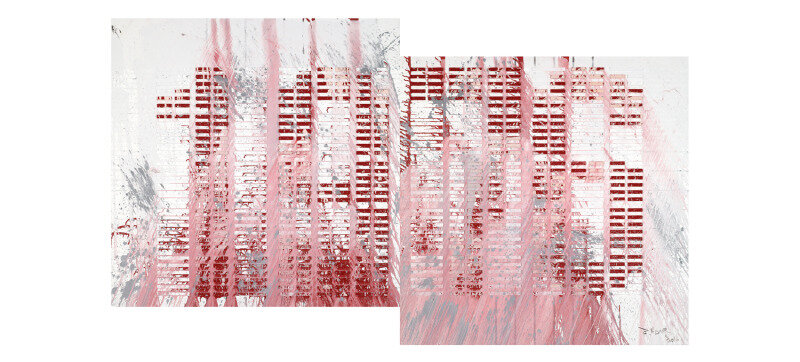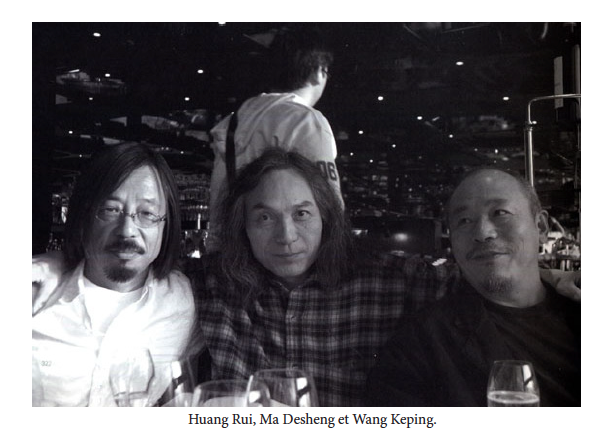PARIS
Huang Rui
1976
Sept 9 - Oct 15, 2016
Vernissage et performance le samedi 3 septembre de 18h à 20h.
L’œuvre de Huang Rui constitue une introduction privilégiée à l’histoire de l’art chinois contemporain et un repère indispensable pour en saisir l’évolution après la Révolution Culturelle (1966-1976).
Huang Rui revient sur la signification de l’année 1976 (année de la mort de Mao) qu’il a choisi pour titre de cette exposition. 1976 fut une année marquée par des bouleversements et des mouvements de contestation qui furent à l’origine de ce qu’on a appelé « le printemps de Pékin ».
Huang Rui précise : « 1976 a pour moi valeur symbolique. 40 ans plus tard je réalise quelle fut l’importance de cette année pour moi. En 1977 et 1978, j’ai réalisé plusieurs œuvres à propos de cette année 1976. Par leur caractère abstrait, elles pouvaient représenter la situation dans laquelle je me trouvais alors. Aujourd’hui, 1976 (un diptyque de 2016) est pour moi une œuvre qui réunit le temps et l’espace dans une forme abstraite. Elle fait partie de mes Language Color Paintings. Cette exposition en compte plusieurs. Elles témoignent de mes constantes recherches sur les rapports entre le langage et la couleur. »
Les Language Color Paintings sont intimement liées à la calligraphie. Pour Huang Rui les textes ne sont pas accessoires ce sont des images, à la fois forme et contenu intégrés dans la structure même de la peinture. Parallèlement, dans un autre media, la performance, il ajoute la dimension du live au langage.
Déjà dans ses Space Structure Paintings de 1984, dont quelques exemples seront présentés pour la première fois à Paris dans cette exposition, Huang Rui traçait une cartographie à partir de l’étude de l’architecture chinoise ancienne, en particulier la Cité Interdite et son quartier des anciens hutongs, pour représenter une autre réalité que celle du réalisme socialiste. Mais cette voie personnelle, fondée sur le recours à un langage de couleurs « murales » ou « végétales » : bruns rouges ou gris vert ou bleu des constructions et des cours du vieux Pékin représente moins un relevé qu’un ensemble de combinaisons inspirées du fameux I Ching ou Livre de Divination.
Ainsi le jour du vernissage de l’exposition, le 3 septembre à 19h, Huang Rui se livrera à une performance intitulée « In Search of Trigrams », un concept de spatialité sous forme de figures abstraites, les hexagrammes ou Bagua (2015). Le projet de Huang Rui ressemble à une quête et cette quête est sans fin.
Huang Rui (né à Pékin en 1952) est l’un des artistes chinois contemporains les plus remarquables par son rôle historique, en tant que co-fondateur avec Bei Dao et Mang Ke du journal underground Today, puis en 1978 du premier groupe d’artistes de l’avant-garde chinoise, Xing Xing (Les Etoiles) avec Wang Keping, Ma Desheng et Ai Weiwei…ainsi que par son rôle essentiel dans la création de la zone d’art 798 à Pékin en 2002 et ses efforts pour la protéger de la démolition en 2004 et 2005 qui aboutirent en 2006 à la protection du site et à sa reconnaissance officielle grâce au lancement du Dashanzi Art Festival (DIAF) qui en assure la promotion.
« Huang Rui est l’un des pionniers les plus importants de la nouvelle abstraction chinoise qui s’exprime dans ses Space Structure Series et leur développement lié au processus de la réforme urbaine en Chine » (Tom Berghuis, ancien Curator of Chinese Art au Solomon R. Guggenheim Museum, New York et actuellement directeur du Museum MACAN à Nusantara, Indonesia).
Entré récemment dans les collections du Musée Guggenheim (New York), Huang Rui y participera en 2017 à une exposition sur l’art chinois contemporain (octobre 2017 - janvier 2018).
La Revue “Today!”
Opening and performance on Saturday, September 3rd from 6pm to 8pm
Huang Rui is a reference artist to discover Chinese contemporary art and understand its evolution after the Cultural Revolution (1966-1976).
In this exhibition, Huang Rui looks at the significance of the year 1976 (the year Mao died) he chose as the title of the show. 1976 was a year of upheavals and protest movements, which gave way to the “Beijing Spring”.
Huang Rui says : “1976 is a symbolic year for me. I realize the impact of this year in my life 40 years later. I had already created several artworks about 1976 in 1977 and 1978. Their abstract nature was a way to represent the situation I was in at the time. Today, 1976 (a diptych made in 2016) gathers time and space in the same abstract form. It is one of my Language Color Paintings. There are several of them in this exhibition. They show my constant research on the relationship between language and color. »
The Language Color Paintings are closely related to calligraphy. For Huang Rui, words are not secondary. They are images, both form and content, that he integrates in the very structure of his paintings. On another hand, through performance, Huang Rui adds a live dimension to language.
With his Space Structure Paintings of 1984 -a few of which will be exhibited for the first time in Paris during this exhibition- Huang Rui had already created map artworks inspired by the study of ancient Chinese architecture, especially the Forbidden City and its old hutong district, through which he proposed an alternative to social realism. But this unique series, based on the use of architectural and vegetal colors -the red browns, grey greens and blues of the old Beijing’s buildings and courtyards- was less about mapping than playing on compositions inspired by the famous I Ching, the Book of Changes.
On the day of the exhibition opening, at 7pm, on September 3rd, Huang Rui will give a performance entitled “In Search of Trigrams”, a concept cast into space through the hexagrams, the abstract Bagua figures (2015). Huang Rui’s project is like an endless quest.
Huang Rui (born in Beijing in 1952) is one of China most prominent contemporary artists, for the historic part he played as a co-founder of both the independent underground newspaper Today, along with Bei Dao and Mang Ke, and of the first Chinese avant-garde art group named The Stars Group, in 1978, alongside Wang Keping, Ma Desheng and Ai Weiwei. Huang Rui was also a key actor in the creation of the 798 Art District in Beijing in 2002, and fiercely advocated against its demolition in 2004 and 2005, which led to its protection in 2006 and its official recognition through to the launch of the Dashanzi Art Festival (DIAF) as a promotional event.
“Huang Rui is one of the main figures of the new Chinese abstract movement as shown by his Space Structure Series and the following artworks focused around the urban reform process taking place in China.” (Tom Berghuis, former Curator of Chinese Art at the Solomon R. Guggenheim Museum of New York and current Director of the MACAN Museum in Nusantara, Indonesia).
The Guggenheim museum of New York recently acquired some of Huang Rui’s works, which will be showcased during an exhibition dedicated to contemporary Chinese art in 2017.








